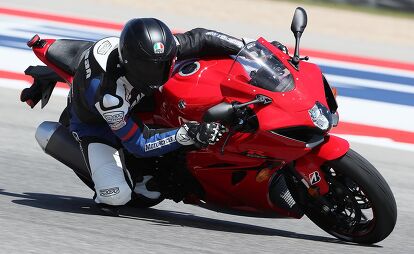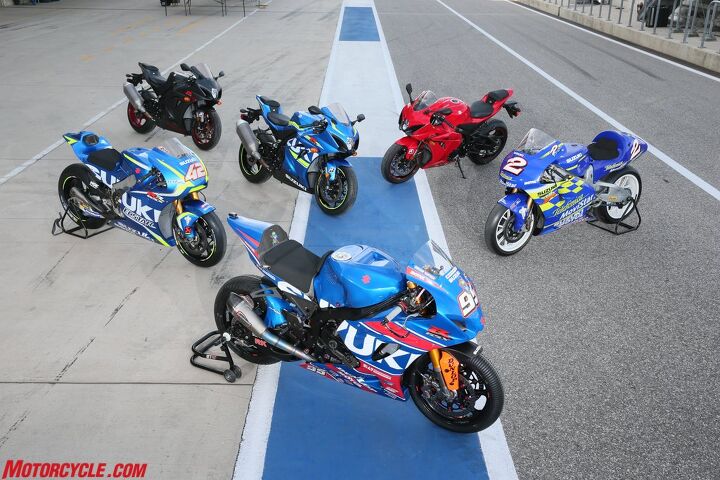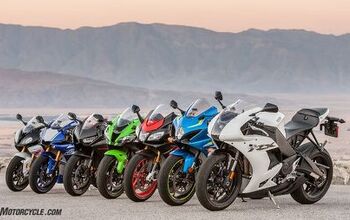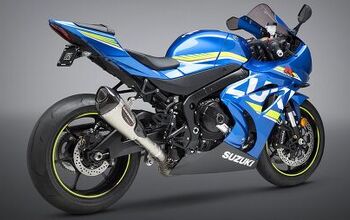2017 Suzuki GSX-R1000 Review

MO's first ride aboard the Gixxer with only one R
Head Cheese Duke may have gotten a chance to ride the new Suzuki GSX-R1000R at Phillip Island – which is probably tied at the top of every moto-journo’s bucket list of tracks to ride alongside the Mugello track in Italy – but as far as consolation prizes go, getting to ride at the Circuit of the Americas in Austin, Texas, is pretty darn good. My steed? Ironically enough, the 2017 Suzuki GSX-R1000. While my bike may be down one R to the one Kevin rode, to underestimate the single-R Gixxer would be a huge mistake. Let’s take a closer look to why.
2017 Suzuki GSX-R1000
| Engine | 18.5/20 |
| Suspension/Handling | 13.5/15 |
| Transmission/Clutch | 8.0/10 |
| Brakes | 7.0/10 |
| Instruments/Controls | 4.0/5 |
| Ergonomics/Comfort | 8.0/10 |
| Appearance/Quality | 8.0/10 |
| Desirability | 8.0/10 |
| Value | 9.5/10 |
| Overall Score | 84.5/100 |
When comparing the double-R versus the single-R, the list of things the latter doesn’t have is rather small. From a hardware perspective, the major difference is a downgrade in suspension. Instead of the Showa Balance Free fork and shock, the single-R gets the Showa Big Piston fork and a standard Showa shock. Good bits, sure, but not top shelf stuff. The rest is down to software. What you won’t see on the single-R Gixxer Thou is a quickshifter, launch control, or cornering-ABS. For ABS-equipped models, the six-axis IMU still calculates pitch under braking, however, and will modulate the brakes if a certain threshold of rear lift is determined.
Otherwise, the GSX-R1000 siblings are identical. Which means both share the same all-new frame, Brembo T-drive 320mm rotors, monoblock four-piston calipers, and of course, the all-new 999.8cc inline-Four with variable valve timing and finger-follower valvetrain, which help it reach its lofty 14,500 rpm redline.
Because the two bikes are awfully similar, there’s not much to say about the technical details of the GSX-R1000 that Duke didn’t cover in his double-R review, so click over there if you want the full technical rundown. Here, we’re going to focus on the single-R’s track prowess, followed by quick impressions from the street in and around the Austin hill country.
Full Speed Ahead
Hopping aboard the new Gixxer, there’s no mistaking you’re on any other sportbike. Familiarity breeds comfort, and the GSX-R feels like an old friend. You’re sitting in the bike rather than on top of it, and the contours just feel similar, despite the fact the seat/tank junction is narrower than before thanks to the frame spars being 20mm closer together than the previous GSX-R.
But of course the big talking point about the Suzuki is its new engine. The only production sportbike to incorporate variable valve timing, the GSX-R really delivers on its claim of having broad, usable power. There are few racetracks in the U.S. that are big enough to let a literbike sing at full song; I’m talking sixth gear, pinned. The Circuit of the Americas is one of those tracks. At 3.4 miles in length, including a 0.62-mile (1km) long straight, the new Gixxer leaps out of the first-gear entry to the straight ferociously, the TC working overtime in the first couple gears to keep the rear from spinning too much while keeping the front just barely skimming above the ground.
Then, somewhere along the way, the variable valves shift their profile and the engine goes into another level and keeps pulling nearly all the way to its 14,500 redline. It’s quite remarkable, really, and totally seamless during the transition. But even more impressive is just how easily that power is to manage. Simply put, the GSX-R is an easy bike to ride fast. Lower the traction control settings and you’ll get a good amount of spin if you want it. At the same time the bike is working overtime to make sure maximum power is being delivered to the ground. That said, if I were to gauge power according to my butt dyno, I’d say the Suzuki is still a few horses shy of the almighty BMW S1000RR, but will give the all-new 2017 Honda CBR1000RR a run for its money.
Suzuki’s Drive Mode Selector is back on the new model, with all three modes still providing full power. The difference comes in the application of power, as A-mode is most aggressive, C-mode least aggressive, and B-mode somewhere in the middle. Track riding favors putting the bike in A-mode, where power is delivered with immediacy but is nothing resembling abrupt or harsh. A-mode, combined with the engine’s healthy torque output, allows a rider to roll through a first-gear corner in second without losing too much time.
Conversely, B-mode’s initial power delivery is slightly, but noticeably, softer for the first few degrees of throttle turn before ramping back up again. In contrast to A-mode, that same corner mentioned above in B-mode can be taken in first gear with less of a concern over covering the rear brake to inhibit the impending wheelie. As for C-mode, well, I didn’t bother trying it as the perfect conditions of our trackday meant there wasn’t much use in softening the power even further.
On the street, however, the immediacy in which A-mode delivers its power can be a little off-putting initially, with a small lurch during on/off throttle. That said, it definitely isn’t too aggressive for canyon riding, but I’d switch it down to B-mode otherwise. As far as shifting goes, the lack of a quickshifter is definitely missed (though it’ll soon be available as an option), but otherwise shifts are nice and crisp. A slip-assist clutch works well to provide a light lever pull and eliminate rear-wheel hop during rapid downshifts.
Power and Control
Apart from the Suzuki’s engine, its chassis is equally as impressive. During the tech presentation the night before our ride, none other than 1993 World Champ Kevin Schwantz addressed the crowd. KS34 has probably put more laps aboard the new GSX-R than anyone, and the thing he said impressed him the most was how easy the bike was to trailbrake. “Past GSX-Rs would fight me when I turn in on the brakes,” he said. “Not this one.”
Of course, as much as I respect Mr. Schwantz, the journalist in me had to be skeptical of his claims. He is Suzuki’s favorite child, after all. Turns out, I had no reason to doubt the legend; the GSX-R really is sublime while trailbraking into a corner. Grab the binders, tip the bike in, plant your knee down, clip the apex – the Suzuki does it in one fluid motion.
That said, the new bike lacks that nth degree of confidence at max lean as, say, an Aprilia RSV4. Perhaps a result of the lower-grade suspension, the Suzuki is good, but missing that last little bit. And at a claimed 443 lbs with its 4.2-gallon tank full, the Gixxer’s claimed curb weight is nearly 20 lbs heavier than the Euro-spec Honda CBR1000RR I put on the scales during its launch (yes, it had a full tank of fuel). You feel that weight during side-to-side transitions. Calling it sluggish would be a disservice to Suzuki, but it’s just a hair short compared to the class leaders. At the end of the day, these are nitpicks if there ever were any, but because the literbike field is so stacked, any imperfection, no matter how little, has to be mentioned.
Since we’re on the topic of nitpicks, the GSX-R’s brakes are simply good, but far from class leaders. Despite the Brembo logo on the four-pot calipers, these are a far cry from the company’s awesome M50 calipers. On top of that, at 320mm, the Suzuki’s rotors give up 10mm to the best in the field. This combination, combined with rubber lines and street-biased pads results in stopping power that’s simply adequate. Initial bite is relatively soft but consistent, so once you adapt, you know how late you can leave your braking. Steel-braided lines and more aggressive pads would likely improve braking responses.
Where the brakes do deserve credit is with its rear-lift mitigation software. If you’ll remember from my 2017 Honda CBR1000RR Review, I complained about how Honda’s proprietary RLM software resulted in inconsistent braking feel at the lever, causing myself and others to miss corners on occasion. On the Suzuki, stomping on the brakes from 175 mph down to 40 mph takes some serious braking effort, and while I could (at times) feel the lever pulsing in an attempt to keep the rear wheel on the ground, braking force remained consistent – a huge difference compared to the Honda.
Final Thoughts
Without having ridden the double-R Gixxer, I can’t make any comparisons. However, there are some clear takeaways after riding the single-R. First, that engine is killer. Its broad, usable power, while nice at the racetrack, is even more appreciated on the street, where most GSX-R owners will actually ride the bike. Second, its chassis composure under braking is superb – Kevin Schwantz wouldn’t lie to me. Third, it’s IMU-assisted traction control works well, allowing a certain amount of spin while getting power to the ground. Lastly, it veers on being comfortable, at least for a sportbike. The bars aren’t insanely low, the narrow seat makes it easy to put a foot down despite its 32.5-inch seat height, there’s plenty of room to move around, and the pegs aren’t overly aggressive.
Overall, though, the liter-class sportbike field is incredibly tight. It’ll take a mighty effort to unseat BMW’s S1000RR and the Aprilia RSV4, the latter updated for 2017. However, at $14,599 ($14,999 with ABS), the GSX-R1000 is the least expensive literbike out there, allowing you to take the money you save and spend it on some choice upgrades to make the bike as good, or better, than anything else out there.
In case there was any doubt, the answer is yes, folks, the 2017 Literbike Shootout is going to be a good one.
2017 Suzuki GSX-R1000
+ Highs
- Fantastic engine
- Great agility while on the brakes
- Cheapest literbike in the class
– Sighs
- Sucks you gotta pay extra for a quickshifter
- Brakes are just average for the class
- Maybe a smidge heavy

Troy's been riding motorcycles and writing about them since 2006, getting his start at Rider Magazine. From there, he moved to Sport Rider Magazine before finally landing at Motorcycle.com in 2011. A lifelong gearhead who didn't fully immerse himself in motorcycles until his teenage years, Troy's interests have always been in technology, performance, and going fast. Naturally, racing was the perfect avenue to combine all three. Troy has been racing nearly as long as he's been riding and has competed at the AMA national level. He's also won multiple club races throughout the country, culminating in a Utah Sport Bike Association championship in 2011. He has been invited as a guest instructor for the Yamaha Champions Riding School, and when he's not out riding, he's either wrenching on bikes or watching MotoGP.
More by Troy Siahaan







































































































Comments
Join the conversation
A mode on the track. B mode on the street. Makes sense to me. These engineers know what they're doing. Good review, Trizzle.
"Simply put, the GSX-R is an easy bike to ride fast."
Every racer I've ever heard, when he wants to say something good about his bike, he says it's easy to ride. I'm very interested to see how the shootout goes, whether that last degree of performance is really missed when you have a bike that's easy to ride.
Nice article. Appreciate the legacy impressions of Suzukis. I now own my first, a 2016 GSX-S1000. After reading this article, I know I have exactly the bike I need.